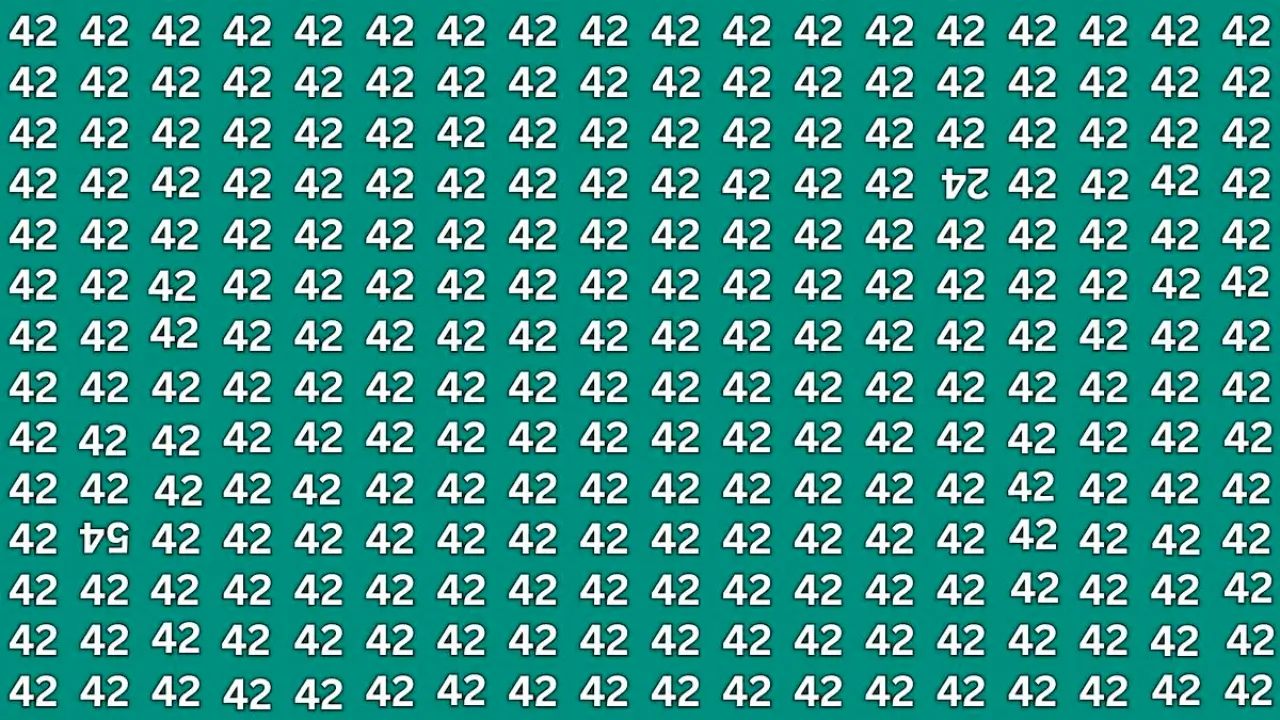Optical illusions are intriguing exercises for the brain, designed to confuse perception and challenge visual intelligence. Among the most engaging illusions are number-based puzzles, where viewers must locate hidden or inverted numbers within a cluster of similar digits.
The challenge “Spot the inverted 24 and 54 among 42s” has recently gained popularity for its difficulty, as it pushes participants to distinguish very subtle differences between numbers that look almost the same at a glance.
This article explores the deeper psychology behind such illusions, explains why spotting inverted numbers is so difficult, and provides detailed insights into visual tricks, attention spans, and brain functioning.
It also covers the broader benefits of engaging in number-based vision challenges and identifies how illusions like the 42 puzzle test pattern recognition.
Why Are Number-Based Optical Illusions So Difficult?
The challenge of finding inverted 24 and 54 among multiple 42s may seem simple at first, but it is visually demanding. The human brain tends to rely on patterns for quicker recognition.
When numbers share similar shapes—like the digits “2,” “4,” and “5”—the brain automatically groups them together, overlooking very slight differences.
For example:
- 42 and 24 use the same digits, but the order is reversed. When they are inverted or rotated, the similarity makes spotting the distinction far more complex.
- 42 and 54 share one common digit, and because “5” and “2” can both resemble each other in certain stylised fonts or flipped positions, the human eye often perceives them as identical under pressure.
This optical illusion deliberately targets human reliance on shortcuts in recognition, testing how quickly and accurately people can process similarities and differences in shapes.
The Science Behind Number Illusions
In cognitive psychology, pattern recognition is a core ability that helps the brain avoid overload. Instead of analysing every detail, it tries to match visual input with already known structures.
Optical illusions take advantage of this process by deliberately creating setups where reliance on these shortcuts leads to errors.
Illusions like spotting 24 and 54 among 42s trigger confusion because:
- Visual Crowding: Placing many repeating 42s narrows focus, overwhelming the brain with near-identical patterns.
- Similarity in Form: Digits with comparable structures (2, 4, and 5) blend together when placed closely or inverted.
- Cognitive Load: The subtle differences require a higher level of concentration than everyday recognition tasks.
- Time Constraint Effect: Adding time pressure enhances difficulty, as the brain is forced to scan rapidly.
Engaging in such illusions is more than mere entertainment; it has measurable benefits for the mind.
Benefits of Playing Optical Illusion Challenges
Number-based puzzles such as finding inverted 24 and 54 among 42s are not only fun but beneficial for mental agility. They help improve:
- Attention to Detail: By forcing concentration on subtle differences, the brain learns to slow down visual scanning.
- Memory Recognition: Regularly engaging in these puzzles sharpens short-term memory by reinforcing recognition patterns.
- Concentration and Patience: Completing challenging visual illusions requires persistence, boosting focus levels.
- Problem-Solving Skills: Thinking beyond automatic recognition helps in both analytical and creative thinking tasks.
Such exercises are therefore widely used in educational, recreational, and even neurological fields to test perception abilities.
Why 24 and 54 Are Hard to Spot Among 42s
Shape Similarities That Confuse the Brain
The similarity between these sets of numbers is not accidental—it is the scientific backbone of the illusion. Below is a closer look at how these numbers create visual confusion:
| Number | Visual Traits | Why It Blends with 42 |
| 42 | Angular “4” with rounded “2” | Base pattern causing repetition |
| 24 | Same digits reversed | Order change barely noticed in dense clusters |
| 54 | “5” often similar in font to “2” | Causes confusion when inverted or stylised like “42” |
This demonstrates why optical illusions grounded in numbers are so effective—they create cognitive traps that exploit the human brain’s recognition shortcuts.
Strategies To Spot Inverted Numbers Successfully
While many fail initially, there are techniques to enhance performance when solving this type of optical illusion:
- Slow Scanning: Instead of rushing, focus on each digit in sequence rather than treating clusters as whole symbols.
- Pattern Breaking: Train the brain to identify subtle asymmetries in repeated digits.
- Use Visual Anchors: Notice whether the “2” comes first or second; this drastically reduces confusion with 24.
- Spot Curves and Angles: Differentiating between the roundness of “5” and the pointed angle of “2” is key to identifying 54.
Practising these methods regularly makes number-based puzzles far less intimidating.
Why People Love Optical Illusions Like These
Optical illusions are culturally and socially popular for several reasons:
- They provide entertainment while engaging critical thinking.
- They create competitiveness, as people enjoy timing themselves or comparing performance with friends.
- They improve brain exercise, supporting neurological health in a playful manner.
- They enhance confidence, as solving a difficult illusion creates a sense of accomplishment.
Illusions that require spotting hidden objects or numbers combine visual fun with cognitive learning, making them a timeless type of puzzle.
Psychological Insights From the 42 Puzzle
The “Inverted 24 and 54 among 42s” illusion becomes more than just a puzzle once studied deeply. Psychologists use similar pattern tests to evaluate fields such as:
- Attention disorders: Measuring how well an individual can focus on small details under pressure.
- Visual intelligence: Assessing a person’s ability to differentiate subtleties in busy environments.
- Cognitive resilience: Observing how participants react to errors and persevere through confusion.
Thus, what might look like a light-hearted internet challenge actually connects to scientific methods of measuring perception and cognition.
Beyond Numbers: Wider Use of Optical Illusions
Though this puzzle deals with numbers, similar techniques apply to images, words, and graphics. For example:
- Camouflaged animals in nature often rely on illusions of form and blending, echoing the same recognition trick.
- Hidden word puzzles employ inversion or mirroring to challenge linguistic processing.
- Abstract art uses optical confusion to evoke curiosity and interpretation.
Therefore, illusions are not only fun games but also rooted in science, art, education, and even survival instincts.
FAQs
1. Why is the “Spot the inverted 24 and 54 among 42s” puzzle so tricky?
It is difficult because the numbers share structural similarities, and the dense repetition of 42s makes the eyes gloss over small differences.
2. How can I improve at solving optical illusions like this?
The best way is to slow down, scan numbers methodically, and train your brain to notice order and shape differences.
3. Do such illusions really help improve brain function?
Yes, they sharpen attention, concentration, and pattern recognition, which are key skills for everyday problem-solving.
4. Is this kind of puzzle more about vision or about the brain?
While it involves eyesight, the main challenge is in the brain’s recognition processes and reliance on visual shortcuts.
5. Can anyone solve these puzzles quickly, or is it a natural ability?
With practice, anyone can improve speed and accuracy, though some people naturally have sharper pattern recognition skills.














